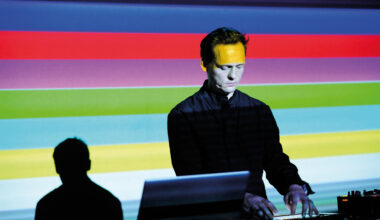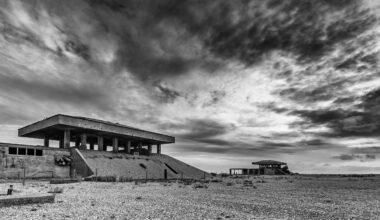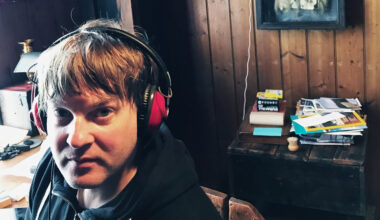Way ahead of their time, Section 25 were one of Factory’s most inspired signings. Drummer Vin Cassidy looks back on the early years of the label and how his band came into its orbit
Though they may have hailed from a small town near Blackpool, Section 25’s spiritual home was the Manchester of the early 1980s. Formed in 1978 in Poulton-le-Fylde by bassist and vocalist Larry Cassidy, his drummer brother Vin and guitarist Paul Wiggin, Section 25’s gothic grooves quickly coalesced with the sounds emanating from the city just 50 miles away.
“You gravitate to where you think there’s a bit of a thing going on,” says Vin Cassidy. “Looking back now, it was quite a special time.”
Of all the acts signed in Factory’s early days, Section 25 were the most enigmatic. With their mutant mix of serrated guitar scrapes, disco drums and sparse, dub-like bass, they were light years ahead of their time. Guitarist Paul Wiggin, who had no musical training, used his instrument for texture, noise and effects rather than melodies or chords, while the Cassidy brothers created a sinuous rhythmic undertow influenced by their Buddhist beliefs.
“It was quite experimental, but it kind of clicked,” says Vin.
The band were omnivorous in their tastes, absorbing not just the raw guitar sound of the time, but also the reverberations of other musical outliers.
“We caught the arse end of punk,” says Vin. “Larry and Paul were into Throbbing Gristle, and experimental music. Paul used to listen to Stockhausen and Can; a lot of krautrock.”
In a not uncommon tale, it was Joy Division who brought Section 25 into the orbit of Factory. Larry had bought the ‘An Ideal For Living’ EP and they went en masse to Liverpool to catch them live at Eric’s.
“We went to see Tanz Der Youth,” says Vin. “The guitarist was Brian James who had been in The Damned, so we were fired up about that. For some reason, they had the support acts on Saturday nights after the main bands. We hung around, and the place was pretty much empty when Joy Division came on. We were quite impressed because the band were OK to talk to you afterwards. They were quite ordinary and approachable. We were struggling for gigs and thought, ‘We’ll put one on’.”
Staging a charity night at Blackpool’s Imperial Hotel, Section 25 persuaded Joy Division and Orchestral Manoeuvres In The Dark, another early Factory signing, to join the bill. Joy Division’s manager, Rob Gretton caught the Section 25 set, liked what he heard, and the band soon found themselves recording their first single, ‘Girls Don’t Count’, for Factory with Ian Curtis and Gretton producing.
“Gretton was an interesting guy, quite bullish,” says Vin. “He was one of the lads. Ian was a bit more reserved, but there was no star thing going on or anything. Looking back I realise they had virtually no studio experience, but they had a little bit more than we had!”
The occluded bass and strafing six-string clangour of ‘Girls Don’t Count’ [FAC 18] was released in July 1980. Though Gretton and Joy Division loved Section 25, Vin remembers Tony Wilson being initially unconvinced.
“I remember Rob saying, ‘Tony doesn’t like it, but it’s going to come out anyway’. He thought it was the ‘sort of thing’ that should come out on Factory.”

Vin found Tony Wilson a mercurial presence, startling in his ability to change hats as Granada TV presenter and label boss.
“He had his TV career,” says Vin, “so we were a bit in awe of him. You’d be dealing with him to do with a release, and then you’d put the telly on at six o’clock, and there he was. He was kind of a split personality, but he was always really enthusiastic, supportive and interested.”
Prior to the death of Ian Curtis, Joy Division acted as mentors to Section 25, and they would often play gigs together, sometimes joining each other on stage.
“We’d do a lot of support slots with Joy Division,” says Vin, “and when they were doing an encore, we’d sometimes come on and be playing. Everybody was into doing it, it was pretty out there.”
‘Unknown Pleasures’ remains Vin’s favourite release from the Factory catalogue, both for its sound and its personal significance.
“In terms of what it means, and the people involved, and what happened. I don’t just mean as a piece of music, obviously it’s astounding, but as a whole thing.”
Section 25’s 1981 debut album was released under the title ‘Always Now’ [FACT 45], though it could have had a more profane name if Rob Gretton had got his way.
“He wanted to call our first album ‘Fuck Off’ and put it in a rubber sleeve,” says Vin, “I wish we had.”
‘Always Now’ brought them into the sphere of Martin Hannett, Factory’s in-house producer. The sepulchral Hannett sound that defines the label’s earliest releases was a perfect fit for Section 25, and though Hannett had something of a reputation for remoteness and strange demands, Vin says he was easy to work with.
“He gave the music a big, architectural feel, a breadth to the sound,” says Vin. “I listen to his production work and there’s still a freshness to it. Working with Martin wasn’t a chore. I’ve heard stories where he’s turned the air conditioning up so high, he’s literally frozen people out of the room. But for us, if you’re going to get a producer, he’s going to produce. We gave him free rein pretty much. We always found that, if we approached it the right way, he was OK about it. We were into experimentation and seeing what would happen, so maybe that fitted in with things.”
After their self-produced, more exploratory second album, ‘The Key Of Dreams’, released by Factory Benelux, Section 25 began to favour an electronic sound, constructing tracks with mostly synths and drum machines.
“The equipment was becoming more affordable,” says Vin. “So we were looking at different approaches. Larry’s wife Jenny Ross, who was a very competent keyboard player and a good vocalist, was getting involved and we just came up with this stuff that was quite a departure from anything we’d done before.”
Demos for the new material, which became the album ‘From The Hip’ [FACT 90], were enthusiastically received, and the band were dispatched to the expensive Rockfield Studios in Wales to record.
Bernard Sumner, already a friend of the band from the Joy Division days, was in the producer’s chair, and helped impart the electronic music wisdom he’d absorbed from New Order’s increasingly synth-driven songs.
“The thing with Martin Hannett,” says Vin, “is it was a master and pupil relationship. We wanted to get more involved in the production. Bernard was in the same place as us. It was a more democratic thing. He’d take on-board what we were doing and we’d listen to him, the deciding factor was if it was sounding good, it would stay in. He was more into the electronic approach and using sequencers, so it was a natural progression.”
It worked well, with the album yielding Section 25’s biggest hit, ‘Looking From A Hilltop’, a track often seen as a proto-dance classic. Though there was one further album in Section 25’s early incarnation, ‘Love & Hate’, Vin left in 1985 before its release. In 2007, they reconvened, and have produced a plethora of albums since.
Vin has fond memories of the Factory years, and, with the death of his brother Larry in 2010, its sense of family.
“Looking back, there was quite a lot of that. At the time, you’d have to ask your mates to help you out. I suppose that’s where that came from.”
As to the label’s legacy, Cassidy never imagined it would have the impact it had.
“Overall, Factory is a brilliant thing,” he says. “I know Paul is proud to have been part of it. My brother was very proud of our releases and our connection with it. I think Tony Wilson wanted to leave something behind that would stand the test of time. He succeeded, didn’t he, really?”






